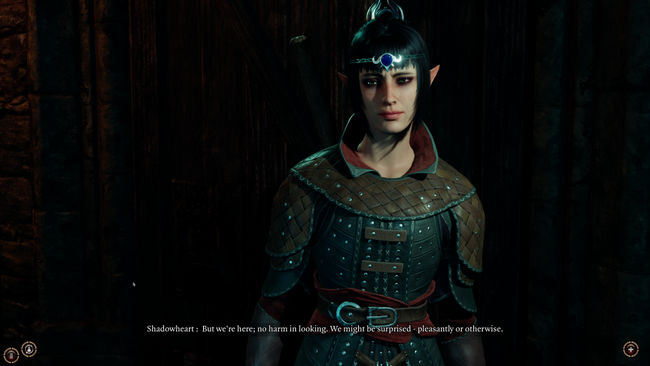
Baldur's Gate 3 Cleric Class Guide - Pick the best Domains, equipment, and spells
The epitome of the divine spellcaster in Dungeons & Dragons, the Cleric has the power of a god on their side. Picking one of many deities to worship Clerics draw their power from the blessings of their patron, and in a party of adventurers, a little divine help goes a long way. In Baldur’s Gate 3, Clerics put the lie to the stereotype of a “squishy” spellcaster, with surprising durability and spells to both heal the party and harm the enemy.

Before You Begin
Note that none of these points are set in stone. Build your character the way you choose, and see these notes more as suggestions than rules.
This guide will also assume that you are building a custom character. Origin Characters have unique interactions and roleplaying options available thanks to their preset nature. If you’d like to play a Cleric Origin Character, consider choosing Shadowheart as your Baldur’s Gate 3 protagonist.
Additionally, this guide presumes you are building a single-class character. Multiclassing into different classes as you level up is an option to gain new and useful abilities, but there’s also value in specialization. We’ll have some multiclass suggestions for you at the end of the guide.
The Cleric Playstyle
With a default level cap of 12, Baldur’s Gate 3 puts a premium on readily available support magic, such as healing spells and abilities that improve a character’s performance. No one has a deeper well of such spells than the Cleric. Clerics are also significantly less vulnerable than their arcane caster counterparts, Wizards, since they can wear armor and use shields without hindering their spellcasting.
That said, the Cleric has its own options for dishing out pain as much as relief. There’s also no one you’d rather have by your side than a divine spellcaster when confronted with cross-planar foes like fiends and the undead. Clerics have access to powerful debuffs and a few direct damage spells, and their choices of Domain (their subclass) can unlock unique benefits.

Cleric Class Features
- Key Abilities: Wis and Cha
- Clerics use Wisdom as their primary Ability score, and Wisdom powers their divine spellcasting. Having a high Charisma also helps some of their anti-fiend and anti-undead features. Both Wisdom and Charisma also have a number of associated skills, making Clerics more capable with those proficiencies, if they choose them.
- Clerics use their Wis and Cha bonuses for their saving throws.
- Gear Proficiency: Light Armor, Medium Armor, Simple Weapons, Shields.
- Clerics are best off wearing armor to mitigate their vulnerability. Some supportive Cleric spells require a touch range, meaning that a Cleric devoted to supporting their allies may need to wade into the melee to do their divine best.
- Skill Proficiency: At creation, Clerics can choose two proficiencies out of History, Insight, Medicine, Persuasion, and Religion. Medicine and Persuasion are strong choices that play into the Cleric’s supportive role and take advantage of their natural bonuses. Religion, History, and Insight are somewhat more situational but can unlock narrative benefits.
- Cleric Spellcasting: Clerics can cast divine magic, preparing cantrips and spells much like a Wizard or Sorcerer does. Unlike a Wizard, though, a Cleric gains new spells by picking them from a list as they level up.
- Divine Domain: The choice of Domain is the Subclass choice for a Cleric, and it is made at character creation. Domain choice will unlock certain spells for automatic inclusion in the list of known spells, and unlocks effects for the Channel Divinity power. Domain choices also unlock certain features to alter the Cleric’s playstyle in accordance with their Domain.
- Channel Divinity: This is the Cleric’s signature feature outside of spellcasting. Channeling Divinity allows a Cleric to use energy directly from their chosen deity to fuel a magical effect. The first is the famed Turn Undead ability, which frightens and eventually destroys undead creatures in the vicinity. The second effect is based on the Cleric’s chosen Domain.
- Divine Intervention: Higher-level Clerics can literally call upon their god for assistance. This is a context-specific action but can be invoked as a ritual, asking a god for a powerful and long-lasting (or narrative-specific) boon.
Cleric Gear Recommendations
- Clerics should wear the best armor they can afford. Though they won’t necessarily lead the party directly into combat, their ability to wear light and medium armor without a spellcasting penalty makes them far less vulnerable than a Wizard. A shield helps further with this durability.
- In keeping with the myth that medieval priests were prohibited from using “bloody” weapons in wartime, Clerics are initially only proficient with simple weapons. That said, blunt and bludgeoning weapons like clubs, hammers, and maces are also ideal against the undead, the Cleric’s most stereotypical foe.
- Keep a light Crossbow close at hand. At early levels, a crossbow’s bolts (particularly if a Cleric has high Dexterity) will do as much or more damage than the Cleric’s selection of cantrips, and allow flexibility in ranged combat.

Cleric Subclasses
At creation, Clerics will choose a Divine Domain, which functions as the Cleric's subclass. In Baldur’s Gate 3 there are 7 Domains to choose from: Life, Trickery, Light, Knowledge, Nature, Tempest, and War. Their choice of Domain unlocks Domain Spells for automatic inclusion in the Cleric’s spell list. Some Domain Spells are taken from other classes’ spell lists, meaning that in some cases, such as the Arcana Domain, Clerics will gain access to spells they wouldn’t otherwise know under any circumstances (outside of a multiclass). Domain spells are always treated as “prepared” and don’t take up a spell slot to be ready to cast. Domains also unlock a special power for Channel Divinity, one that suits the Domain choice.
Since some Domain Spells overlap with commonly available Cleric spells and even other Domains, for the sake of readability, we won’t list every possible Domain Spell for each, instead focusing on each Domain’s unique features, notable spells, and other bonuses.
Life Domain
Life Clerics are the Clerics that heal above and beyond other Clerics. Though their Domain Spells don’t branch out much into other classes’ lists, a Life Cleric has many healing and restoration-related Domain spells, ensuring they can use valuable spell slots on other spells. They also gain Heavy Armor proficiency, making sure they stay alive long enough to keep everyone else on their feet. With Divine Strikes in the later levels, Clerics can sustain themselves even in the thick of close combat. Their Channel Divinity ability casts a strong AOE heal effect.
Life Domain Subclass Features
- Gear Proficiency: Heavy Armor
- Disciple of Life: Healing spells heal additional HP (2+spell level)
- Channel Divinity: Preserve Life: Heal allies in an area around you.
- Notable Domain Spells: Bless, Cure Wounds, Aid, Revivify
- Blessed Healer: Life Cleric healing spells heal the caster as well.
- Divine Strike: Can cause radiant damage with weapon attacks.
Trickery Domain
Trickery Clerics gain access to some potent debuffs that can disable and distract enemies, as well as the ability to make life a bit easier for the party’s resident Ranger or Rogue. They gain the ability to improve another creature’s Stealth checks, as well as make themselves stealthier through spells. Trickery Clerics also gain access to Dispel Magic, an extremely powerful (if somewhat situational) spell for removing magical effects. A Trickery Cleric with a level or two of Rogue can be a powerful stealth force.
Trickery Domain Subclass Features
- Blessing of the Trickster: Improve another creature’s Stealth checks.
- Channel Divinity: Invoke Duplicity: Summons an illusion to distract a foe, granting nearby allies Advantage on attack rolls against the distracted creature.
- Channel Divinity: Cloak of Shadows: A version of Invisibility for the Cleric.
- Notable Domain Spells: Charm Person, Mirror Image, Blink, Dispel Magic
- Divine Strike: Can cause poison damage with weapon attacks.
Light Domain
Light Clerics fight on the side of light, literally. Their domain spells not only focus on doing Radiant Damage, but also involve elements that produce light, elements like fire. Light Clerics gain access to some potent elemental damage spells, and at later levels heavily improve the effectiveness of their Cantrips, making them much more powerful doing ranged magical damage. This makes Light a favorite choice for Clerics that like to sling spells from the rear lines, rather than mixing it up in the melee. In some ways, a Light Cleric is somewhat like having a Wizard in the party, given their excellent capacity for toasting groups of weaker foes.
Light Domain Subclass Features
- Warding Flare: Defend yourself against an attacking creature by using divine light to impose disadvantage on its attack roll, blinding it as it tries to hit you. At higher levels, Warding Flare can be cast on a nearby ally.
- Channel Divinity: Radiance of the Dawn: A powerful AOE Radiant damage power that also temporarily dispels darkness.
- Potent Spellcasting: Add Wisdom Modifier to damage dealt by Cleric cantrips.
- Notable Domain Spells: Faerie Fire, Burning Hands, Scorching Ray, Fireball
Knowledge Domain
For a Cleric with this domain, knowledge is literal divine power. Knowledge Clerics gain a number of useful options pertaining to skills, ones that potentially unlock new solutions to quests and interactions. They can even call on the blessings of their deity to temporarily use items and skills they’d not have access to otherwise. Is your party’s Rogue unavailable? Channel some Divinity and pick up those Thieves’ Tools to crack the safe!
Knowledge Domain Subclass Features
- Blessings of Knowledge: Become proficient in two of the following skills: Arcana, History, Nature or Religion, doubling your proficiency bonus.
- Channel Divinity: Knowledge of the Ages: A fantastically useful utility ability, allowing Knowledge Clerics to temporarily gain proficiency with any skill or tool they need.
- Channel Divinity: Read Thoughts: A powerful, if situational effect that allows you to see what a creature is thinking in the moment, which can be critical for sussing out information during interactions.
- Potent Spellcasting: Add Wisdom Modifier to damage dealt by Cleric cantrips.
- Notable Domain Spells: Speak with Dead, Nondetection, Command, Identify
Nature Domain
Nature Clerics walk (or pray) hand-in-hand with members of the Druidic tradition. They gain access to cantrips and some spells from the Druid spell lists, and can use their divine access to work magic on animals, plants, and the elements. Nature Clerics gain some useful area control abilities, and can up their melee performance damage by quite a bit thanks to gaining access to the normally Druid-exclusive Shillelagh spell. By later level they’ll be able to use their Divine Strike ability to inflict elemental damage of their choice, further bolstering their close combat prowess.
Nature Domain Subclass Features
- Acolyte of Nature: Gain a bonus cantrip from the Druid spell list. Gain proficiency in one of the following skills: Animal Handling, Survival, Nature.
- Gear Proficiency: Heavy Armor
- Channel Divinity: Charm Animals and Plants: A somewhat situationally useful ability that can quell hostile animals and plants.
- Dampen Elements: When you or a nearby ally takes elemental damage (acid, cold, fire, lightning, or thunder), you can grant resistance to that damage for that hit, reducing the damage taken.
- Divine Strike: Cause weapon attacks to deal extra cold, fire, or lightning damage (your choice).
- Notable Domain Spells: Barksin, Spike Growth, Speak With Animals, Wind Wall
Tempest Domain
The stormy, blustering counterpart to the Light Domain Cleric, the Tempest Domain harnesses weather-derived magic to turn the Cleric into a potent source of crowd control and damage, swinging away at the eye of the melee storm. Tempest Clerics also gain proficiency with heavy armor and martial weapons.
Tempest Domain Subclass Features
- Wrath of the Storm: Deal lightning and thunder damage to creatures that attack you
- Gear Proficiency: Heavy Armor, Martial Weapons
- Channel Divinity: Destructive Wrath: Use divinity to guarantee maximum damage when dealing lightning or thunder damage.
- Thunderous Strike: Add knockback effects to the lightning damage you deal.
- Divine Strike: Cause weapon attacks to deal extra thunder damage.
- Notable Domain Spells: Thunderwave, Shatter, Call Lightning Sleet Storm
War Domain
Clerics in the War Domain close the gap with Paladins in terms of up-close martial prowess. Combined with their spellcasting, the War Cleric brings divine justice on the business end of their weapon. They gain extra attacks, gear proficiency, and lean hard into making the most of their Divine Strikes.
War Domain Subclass Features
- War Priest: Gain bonus attacks when making weapon attacks, with the number of charges increasing with the Wisdom modifier.
- Gear Proficiency: Heavy Armor, Martial Weapons
- Channel Divinity: Guided Strike: Add a bonus to your attack roll.
- Channel Divinity: War God’s Blessing: Grant attack roll bonuses to a nearby ally.
- Divine Strike: Cause weapon attacks to deal extra damage. The damage is the same as the damage of the weapon.
- Notable Domain Spells: Spiritual Weapon, Crusader’s Mantle, Spirit Guardians, Shield of Faith

Cleric Level Progression
These are the class features you’ll get as you level up as a Cleric. The maximum level cap in Baldur’s Gate 3 at launch is Level 12. Use this to see what you’ll get at each level and plan accordingly, in case you wish to multiclass.
This guide will also highlight class features you gain based on your subclass choice. For more detailed info about the subclasses, see the sections above. Features gained by a Subclass are labeled with the Subclass name.
Note: Unlabeled benefits are “standard” class features and common to all subclasses.
Level 1
- Cleric Spells:
- 3 Cantrips
- 2 Level 1 spell slots
- Domain Spells
- Divine Domain
- Life: Disciple of Life
- Light: Warding Flare
- Trickster: Blessing of the Trickster
- Nature: Acolyte of Nature
Level 2
- Cleric Spells:
- +1 Level 1 Spell Slot (3 total)
- Channel Divinity: Turn Undead: Cause undead to flee
- Channel Divinity: Domain Effect: Effect based on domain choice.
- Life: Preserve Life
- Light: Radiance of the Dawn
- Trickery: Invoke Duplicity
- Nature: Charm Animals and PLants
- Knowledge: Knowledge of the Ages
- Tempest: Destructive Wrath
- War: Guided Strike
Level 3
- Cleric Spells:
- +1 Level 1 spell slot (4 total)
- 2 Level 2 spell slots
Level 4
- Cleric Spells:
- +1 Level 2 Spell slot (3 total)
- +1 Cantrips known (4 total)
- Feat Selection: Can pick a Feat from All Classes Feat list. While any class at level 4 can pick any of the Feats, not all will be relevant to the class. You can also choose an ability improvement to boost a bonus or eliminate a penalty.
- For Clerics, we recommend one of the following Feats:
- Ability Improvement - 2 points to distribute to any Ability score (to max of 20).
- Mobile - Increases Move speed, Dash distance becomes unaffected by terrain. When moving after a melee attack, you do not provoke an Opportunity Attack.
- Magic Initiate: Cleric - Learn 2 cantrips, 1 Level 1 spell from Cleric Spell List. Use Wis modifier for spellcasting.
- Shield Master - +2 to Dex Saving throws when using a Shield. On successful Dex saves with a shield, you take no damage.
- Skilled - Gain Proficiency in 3 Skills of your choice.
- Tough - +2 HP per level
- For Clerics, we recommend one of the following Feats:
Level 5
- Cleric Spells:
- 2 Level 3 spell slots
- Destroy Undead: Turn Undead upgraded to outright destroy undead creatures that fail a save.
Level 6
- Cleric Spells:
- +1 Level 3 spell slot
- Channel Divinity: +1 Channel Divinity charge (2 total)
- Domain Feature:
- Life: Blessed Healer
- Light: Improved Flare
- Trickery: Channel Divinity: Cloak of Shadows
- Nature: Dampen Elements
- Knowledge: Channel Divinity: Read Thoughts
- Tempest: Thunderous Strike
- War: Channel Divinity: War God’s Blessing
Level 7
- Cleric Spells:
- 1 Level 4 Spell slot
Level 8
- Cleric Spells:
- +1 Level 4 Spell slot (2 total)
- Feat Selection: Can pick a Feat from All Classes Feat list or Ability Score Improvement.
- Improved Destroy Undead: Destroy Undead is more likely to succeed.
- Domain Feature:
- Life, Trickery, Nature, Tempest, War: Divine Strike - Extra damage on weapon attack
- Light, Knowledge: Potent Spellcasting - + Wis Modifier to damage from cantrips
Level 9
- Cleric Spells:
- 1 Level 5 Spell slot
- +1 Level 4 spell slot (3 total)
Level 10
- Cleric Spells:
- +1 Level 5 Spell slot (2 total)
- +1 cantrip known (5 total)
- Divine Intervention
Level 11
- Cleric Spells:
- 1 Level 6 Spell slot
- Improved Destroy Undead
Level 12
- Feat Selection: Select a feat or improve an Ability Score.

Multiclass Clerics
Clerics already gain a goodly amount of “cross-class” benefits simply from their choice of Domain, but one or two levels in another class can help a Cleric lean into their strengths or cover for a role in the part.
A Cleric with an extra level in Rogue can take advantage of the Rogue’s wide skill set, as well as improve their stealth performance. Rogue levels might be of particular benefit to Trickery Domain Clerics.
A level or two of Paladin can give a Life Domain Cleric some added martial prowess without compromising their always-ready healing capabilities. Life Clerics already get Heavy Armor proficiency, so the goal with taking Paladin Levels is to trade access to Level 6 spells in exchange for access to Lay on Hands, Divine Sense, Divine Smite, and a Fighting Style.
Clerics tend to have higher Charisma, which is the main ability of the Bard. A level of Bard can net a Cleric access to a set of otherwise closed skill proficiencies, as well as the powerful Bardic Inspiration and Performance benefits.
Some Clerics who like to mix it up in melee can pick up a level of Druid, less for access to the Druid's unique spell list (that's what the Nature Domain is for), but for a taste of Shillelagh, a Druid-exclusive cantrip that turns the caster's weapon into a magical weapon and allows them to use their Wisdom modifier in attack rolls. This is a great boon for Clerics who don't usually have a lot of points to put into their Strength score.